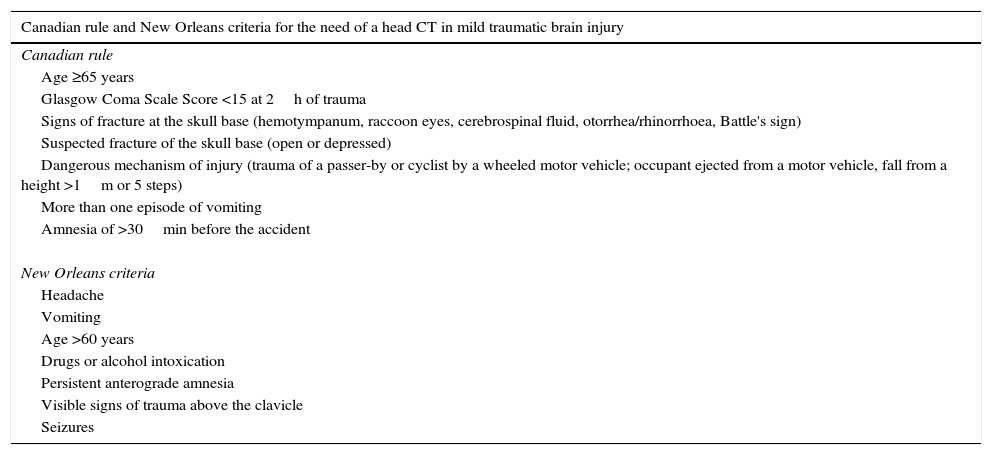To compare two scales for assessment of patients with mild head injury. The Canadian CT head rule (CCHR) and New Orleans criteria (NOC) according to their diagnostic accuracy in patients attending an emergency department, and to determine the most important predictive values.
MethodCross-sectional study in a first-level Hospital in the period of January 2011 to January 2013. Patients with mild head injury criteria were included. All the patients underwent a computed tomography (CT) of the head as part of internal protocol and the CCHR and NOC criteria were recorded for each patient. We consider the main variable the presence of traumatic lesions on CT and, as secondary variables, neurosurgical intervention and post-concussion syndrome. Sensitivity, specificity, predictive values and validity index (VI) of the CCHR and the NO criteria in the subgroup of patients with a Glasgow Coma Scale (GCS) score of 15 points were compared.
ResultsA total of 217 patients, of whom 197 had a GCS score of 15 points were evaluated. Both rules showed 100% sensitivity when a significant injury was presented in the CT, the CCHR 100% (95% CI: 97.4–100%) and the NO criteria 100% (95% CI: 97.4–100%); but the CCHR achieved higher values of specificity 25.3% (95% CI: 18.6–32%), positive predictive value (PPV) and VI.
The two rules showed a 100% sensitivity regarding neurosurgical intervention; however the CCHR with high-risk criteria showed better specificity, PPV and VI 55.2 (95% CI: 8.3–62.2%) compared to the NO criteria 7.6 (95% CI: 3.8–11.5%).
With regard to post-concussion syndrome criteria NO criteria showed better sensitivity 100% (95% CI: 96.2–100%) and predictive values, but lower specificity and VI compared with the CCHR 76.9% (95% CI: 50.2–100%).
ConclusionsOur study demonstrates the high sensitivity of the CCHR and the NO criteria in patients with mild head injury, both to detect a significant clinical lesion on CT or the need for neurosurgical intervention and better specificity of CCHR compared with NO criteria. The adoption of clinical prediction rules, especially the CCHR, to request a CT scan in patients with mild head injury should be recommended in the emergency department.
Comparar 2 escalas para la valoración de pacientes con traumatismo craneoencefálico (TCE) leve, la regla canadiense (EC) y los criterios de New Orleans (NO), de acuerdo a su precisión diagnóstica, en pacientes que acuden a un servicio de urgencias hospitalario, así como determinar los valores predictivos más importantes.
MétodoEstudio transversal realizado en un hospital de primer nivel en el periodo de enero del 2011 a enero del 2013. Se incluyeron los pacientes con criterios de TCE leve. A todos los pacientes se les realizó una tomografía computarizada (TC) de cráneo como parte del protocolo interno y se completó con la EC y los criterios de NO. Consideramos como variable principal la presencia de lesiones traumáticas en el TC, y como variables secundarias la intervención neuroquirúrgica y el síndrome posconmocional. Se compararon la sensibilidad, especificidad, los valores predictivos y el índice de validez (IV) de la EC y de los criterios de NO en el subgrupo de pacientes con una puntuación en la escala de coma de Glasgow (GCS) de 15 puntos.
ResultadosSe evaluaron un total de 217 pacientes, de los que 197 presentaban una puntuación en la GCS de 15 puntos. Ambas escalas mostraban un 100% de sensibilidad cuando se presentaba una lesión importante en el TC, la EC 100% (IC 95%: 97,4-100%) y los criterios de NO 100% (IC 95%: 97,4-100%), pero la EC consiguió mayores valores de especificidad 25,3% (IC 95%: 18,6-32%), valor predictivo positivo (VPP) e IV.
Las 2 escalas mostraron un 100% de sensibilidad en relación con la intervención neuroquirúrgica, y la EC con criterios de alto riesgo consiguió, claramente, una mayor especificidad, VPP e IV de 55,2 (IC 95%: 8,3-62,2%) vs. 7,6 (IC 95%: 3,8-11,5%) de NO.
Con respecto al síndrome posconmocional, los criterios de NO mostraron mayor sensibilidad 100% (IC 95%: 96,2-100%) y valores predictivos, aunque menor especificidad e IV comparado con la EC 76,9% (IC 95%: 50,2-100%).
ConclusionesNuestro estudio demuestra la alta sensibilidad de la EC y de los criterios de NO en pacientes con TCE leve tanto para detectar una lesión clínica importante en el TC como la necesidad de una intervención neuroquirúrgica, así como una mejor especificidad de la EC comparada con los criterios de NO. Se recomienda la adopción de reglas de predicción clínica, en especial de la EC, para la solicitud de un TC de cráneo en pacientes con TCE leve.










